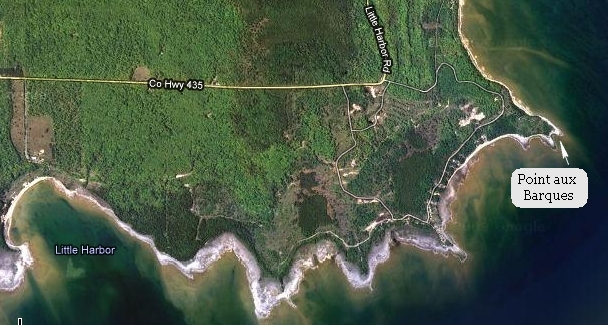Day 8: Friday, June 18th
Another quiet night on the lake and the day broke cloudy and breezy. Although Betsy did not, I think I set a personal record on sleeping in - we did not rise until 8:00! I cannot remember the last time I got up that late in the day.
The temp was now 65 and warming up fast. While Betsy went for a dip I got the stove and food together and made scrambled eggs and bacon. It was quite tasty.
Since we had decided to stay for anther night at East Lake and only reserved for 3 we had called the Forest Service office on Thursday and they wrote up a new permit for us and were going to send someone around on Saturday morning to collect the additional $8 fee for the extra night.
But since we were running low on groceries were decided to drive the 24 miles down to Manistique, pay the fee, and then take a drive down the Garden Peninsula to Fayette Historic State Park and have a look around and then do our grocery shopping after our exploring.
Click on the photos below for a larger image.

A warm sunny morning was good inducement for dip in the lake. Nothing like having your own private beach.
After camp chores we headed to Manistique at 10:45. By then it was hot!.

When we left Manistique, we took US 2 west to Thomson and then picked up County 435 (Little Harbor Road) south towards Garden. Unfortunately this (and the one below) is one of many closed/abandoned/for sale mom and pop hotels we saw all over Michigan.
I can't help but wonder if someday the only option left is the big chain hotel/motels. That would be a bummer.

Lonely and forlorn looking.
While looking at the DeLorme atlas, I noticed a small road of County 435 which went out to a point on Lake Michigan called Point aux Barques. I thought it would be fun to do a little exploring so we decided to check it out.
It was not what I expected. I though it might be a dead end road to a wild part of the shoreline. Well, it did dead end, but the road was lined with log and cedar McMansions the entire length. Many of these were for sale, and many looked empty. We drove as far as the road went and turned around and parked in front of a cabled driveway to the one of the obviously empty "cabins".
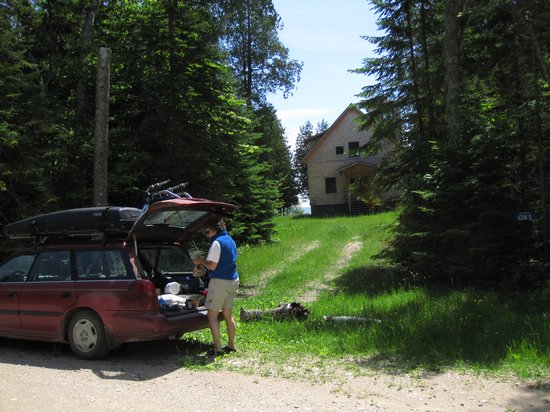
Here Betsy works on making our standard lunch - P,B & Js.
We then took the sandwiches to the back of the house.

How handy the owners had left us a pic-nic (aka: picnic) table to use! What a great place to eat our humble lunch.
There was a steady cool breeze which felt great after the inland heat of the morning.
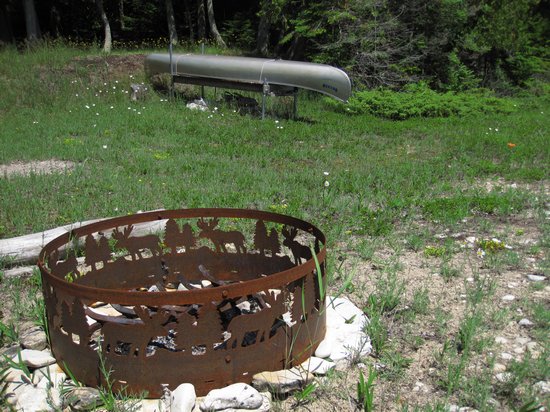
The house, which was unfinished on the inside had all the comforts: microwave, hot plate, coffee maker, etc. All this was set up on large folding table to form a make shift kitchen.
Outside there was this nice fire ring and canoe as well as a tiny enclosed solar shower.

Quite large, like most we saw. Some of the seasonal vacation homes we have seen up here are quite fancy and must have cost small fortunes.
The ground cover in the foreground of this photo is the ubiquitous Bearberry or Kinnikinick(Arctostaphylos uva-ursi).

This is Philadelphia Lily. (Lilium philadelphicum)
We saw it in small numbers just about everywhere we went, often along roadsides. The warm dry weather of April may have affected this plant's bloom period as it was about a month early.
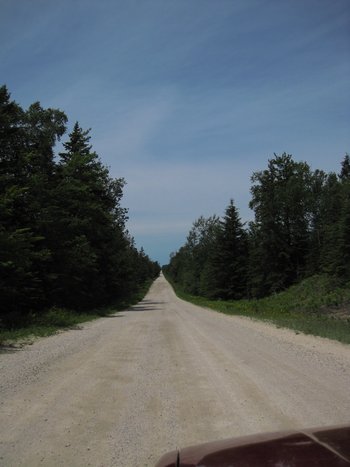
After lunch we drove back out to the main highway. Betsy said this stretch of road reminded her of Dolly Sods back home in good old West Virginny.
We then arrived at the small community of Garden and picked up County 183.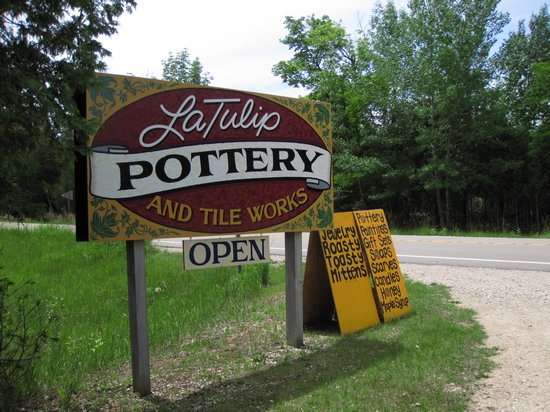
When Betsy spotted this sign about 12 this sign south of Garden I knew we were in trouble. Shopping alert!!
Actually, I was glad we stopped as well. The studio Marsha LaTulip has turns out some interesting pottery, most with motifs of the North Woods, ferns, Thuja, birch and such.

Directly adjacent to the studio was this old barn and silo.

Built to last - as long as they can keep a roof on it.
Just a few more miles south on 483 is Fayette Historic Town site and State Park.

On the way to the Visitors Center I saw this Painted Turtle on the edge of the woods.
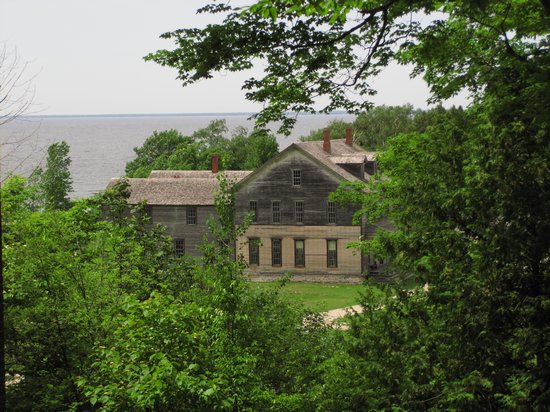
Once a bustling industrial community that manufactured charcoal pig iron between 1867 and 1891, Fayette offers visitors the unmatched serenity of a Lake Michigan harbor, white cliffs and verdant forests. This well-preserved museum village recalls another time when it was a noisy, dirty company town with an immigrant population that shared daily hardships, joys and sorrows.
Source: Michigan DNR

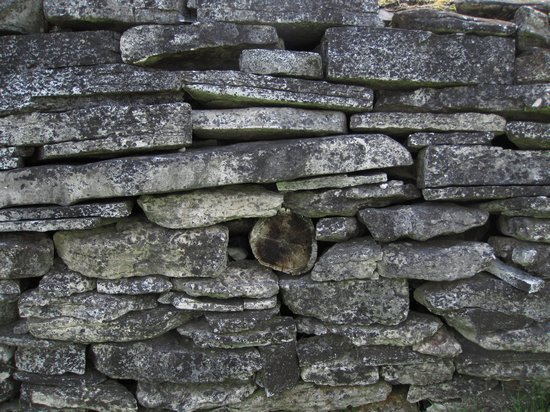
One of the limestone walls quarried from the cliff of the bay shore.

The structures which remain are well preserved for the most part. To the left is the old hotel which boasted second story privies.
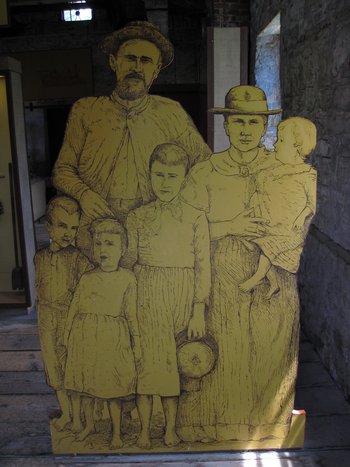
Like most industrial slaves life was hard for the workers and their families. They were paid very little and were isolated from the rest of the world.

1000s of acres of forests were cut to feed the charcoal kilns shown here on the left.
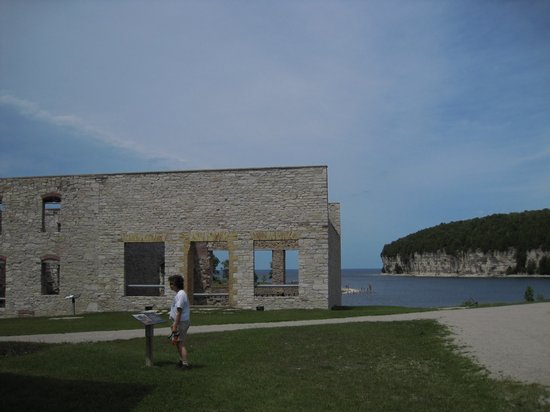
This was the old company store where the company got back most of the wages it paid to the workers. And of course the only place to stay was company owned houses or dorms.

Beautiful stonework!
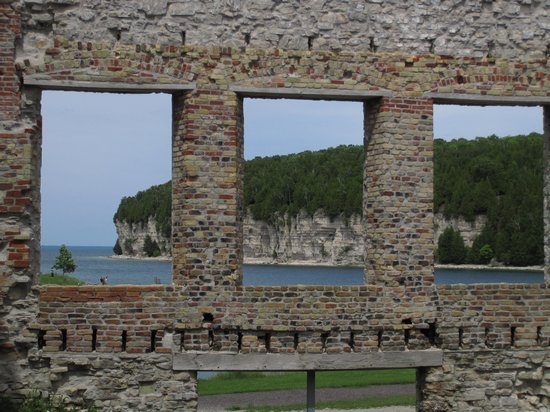
This is the cliff from which all the limestone was quarried.
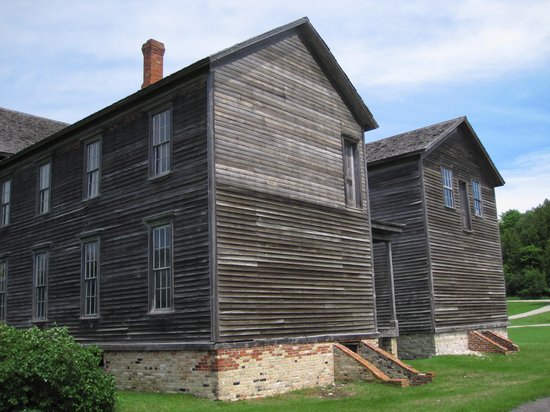
This is the backside of the hotel.
Notice the second story doors. Originally these led into covered walk ways which were connected to the two story privies. Such luxury!

A sign in the old school house.
Better watch out for them pesky whipworms!
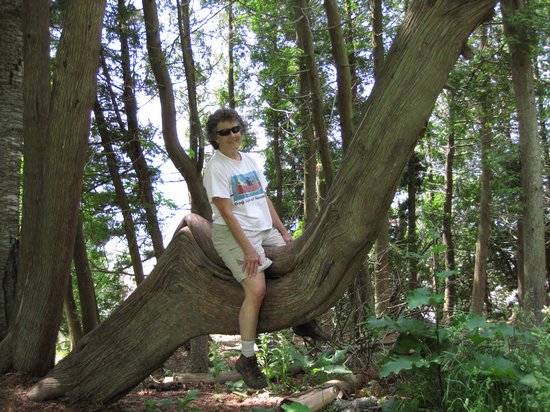
On the bluff overlooking the town there is this interesting looking Thuja. The "saddle" was polished smooth from the thousands of heinies which have sat here.
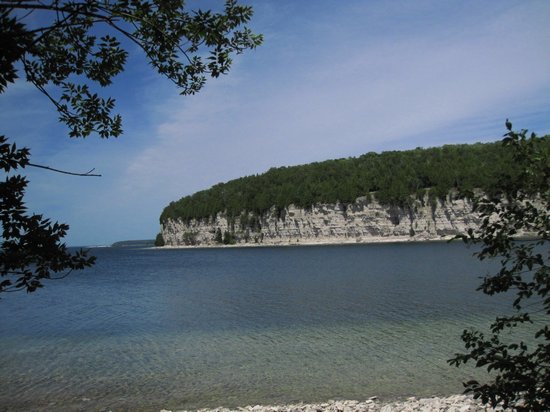
The harbor and shoreline is gorgeous, especially in the crystal clear air and bright sunshine.
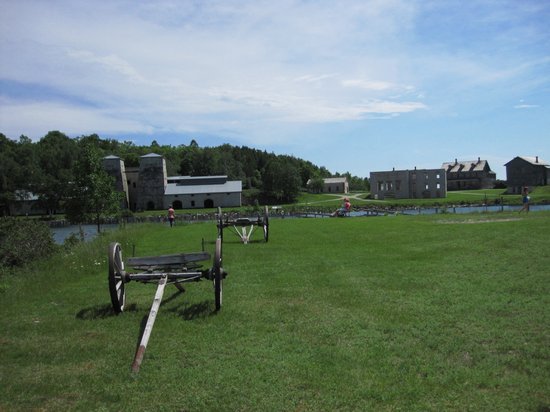
A look back from the "hook" of the harbor.
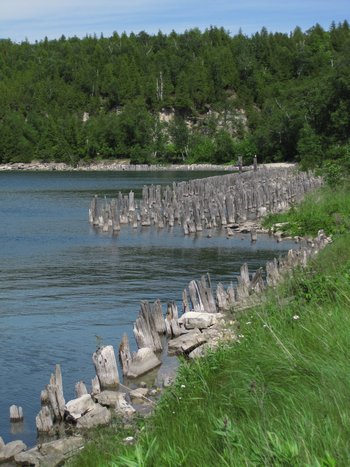
Many of the old pier pilings still remain.
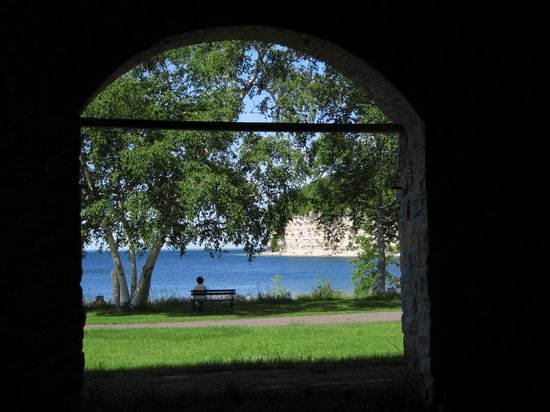
This is looking out from one of the smelters.
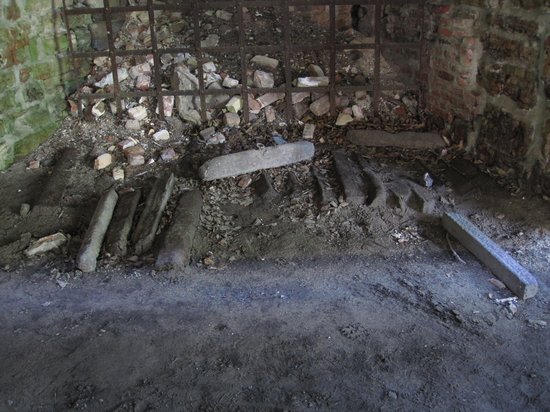
These are some of the iron "pigs". which were made here.

One of the openings of the smelter.
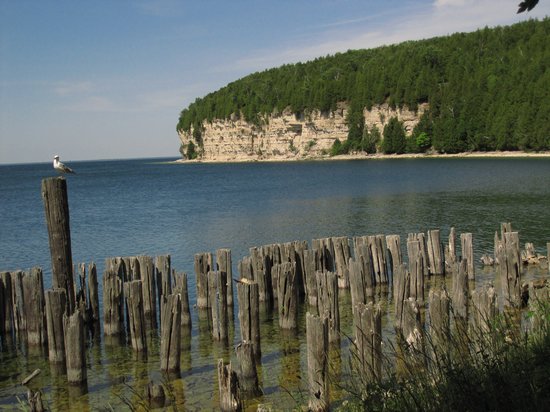
Gorgeous now, but think of the harsh winters the workers and their families endured.
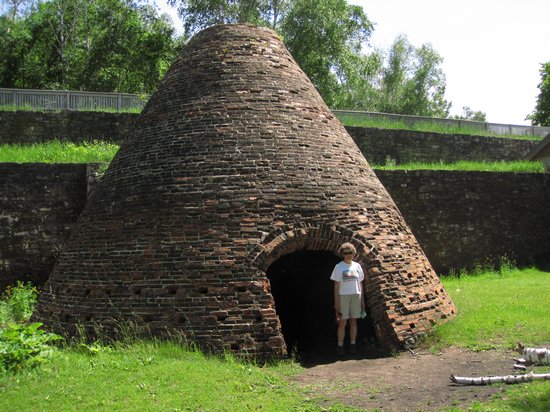
This is a reconstructed charcoal oven. None of the original ones survived..
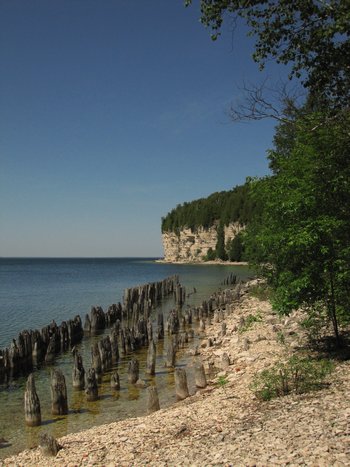

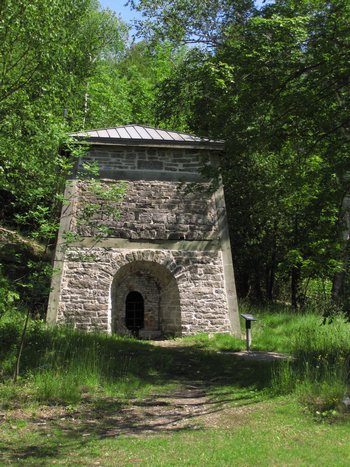
A limestone kiln. Here quicklime was made by heating the limestone..
"Quicklime served many purposes: for use on agricultural land to break up clay soil and 'sweeten' the grass; as a mortar in building; as a flux in iron and steel-making; for lime-washing house walls to make them waterproof; and a decoration to brighten and disinfect the interiors; or, found in heaps at field-gates. to prevent foot rot in livestock. It was also used as a medicine, as a bleach in paper-making, and for removing the hair from hides in leather-making. The effect of lime in contact with moisture also made it useful to sprinkle on cess pits - its caustic action killed off germs and helped decomposition.
In lead-mines lime was used to full the 'jumper' drill holes, it was then wetted and allowed to expand and shatter the rock face... "Although the mai period of activity for the field kilns was between 1750 and 1850, quicklime was in use on land as early as the sixteenth century... "'Two important developments in the agricultural revolution of the eighteenth century were better land drainage and the use of lime.'"
Alastair Robertson in The Bonny Moor Hen 12 (2003)
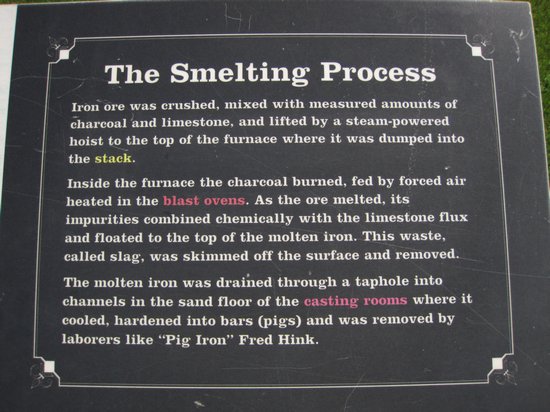

Think about the heat these smelters produced - what the men had to endure who worked close to the open hearth.
The tour of this fascinating place had left us a bit hot and tried so we retreated to the coolness of the visitors center where Betsy treated us to a Mackinac Island fudge ice cream cone.
Next we headed back north into the Hiawatha to check out some other campsites which were listed in the "Dispersed Camping" booklet we had picked up. They were all about 20 miles north of the town of Cooks.
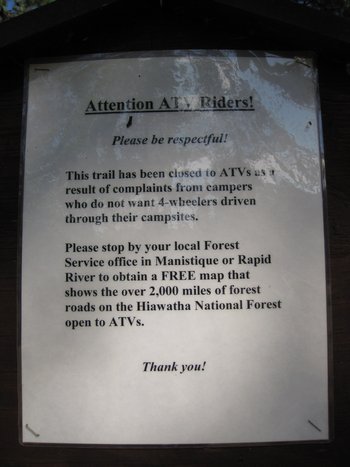
We looked at sights on Bear, Carr and Jackpine Lakes and decided Carr looked best. It had a nicely situated site with steps going down to the water.
This was posted at one of the sites we looked at. I can't remember which one. It looked more like a big turn around than a camp sight.
We then back tracked to Manistique to go grocery shopping.
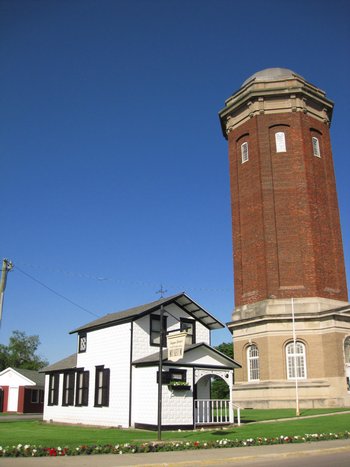
This is the old water tower and Museum in Manistique.
July 7, 1921- EXCAVATION FOR FOUNDATION IS UNDERWAY--- SHEDS FOR MATERIAL AND TOOLS ARE BEING BUILT ---BOND IS ACCEPTED ---LARGE FORCE WILL BE EMPLOYED WHEN WORK STARTS.
On Tuesday of this week, CONTRACTOR Friedolf Danielson put a force of men to work at the city park located at the west end of the city bridge and within a very few days the laying of the foundation will be underway.
The proposed site is suitably adapted for the purpose intended and the building when completed will be very attractive. Besides containing the pumping plant it will support a two hundred thousand gallon storage tank and will be large enough to generate its own power should the necessity ever arise.
Source: Manistique.org
It was now 6:30 and we went to the recently opened Jack's for groceries.
We refreshed our beer supply from their excellent selection, and bought milk, apples, bread and then some items from the deli to put on top of our salad we planned to fix back at camp.
We got back to out quiet and secluded camp, fixed the salad and set up our chairs lakeside and basked in the late evening sun. The cooling breeze helped keep the skeeters at bay. While we sat there in silence, two Sand Hill Cranes flew overhead calling out as they disappeared into the distance.
And then to bed.
